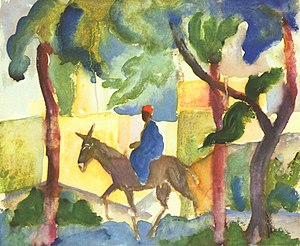Donkey rider

|
| Donkey rider |
|---|
| August Macke , 1914 |
| watercolor |
| 24 x 28.5 cm |
| August Macke House , Bonn |
The donkey rider is a watercolor painting by the German expressionist painter August Macke from 1914. It was created during the art-historically significant trip to Tunisia that the painters Paul Klee , August Macke and Louis Moilliet undertook in April 1914 to Tunisia . The watercolor is now in the collection of the August Macke House in Bonn.
History, description and interpretation
The spring-like lighting conditions in the cities of Tunis , Hammamet , Kairouan and their surroundings made it possible for the three painter friends to have deep artistic sensations, which produced colorful works. No oil paintings were made there, but many sketches, photos and, above all, watercolors. Like his colleague Franz Marc , August Macke had always drawn animals, be it in the zoo or in nature. A donkey appears in several of his pictures that were taken on this trip. Macke himself risked riding a donkey under the guidance of a local. In his photo album there is a picture that shows a donkey rider in motion, which probably served as a template for the watercolor. Paul Klee and August Macke painted with watercolors in the house of the Swiss doctor Dr. Jaeggi, who often invited her to his country house during her stay in Tunis, removed the walls of a room. While Klee was painting the figures of an Arab and an Arab woman, Macke sketched orange baskets and a black donkey and people with red fetters in the background.
The picture shows a dark-skinned rider in a blue robe with a red cap in front of the almost abstract fortress wall of an Arab city (Tunis), consisting of square surfaces, in the flat background that takes the depth of the picture. Macke also placed flat trees and bushes in the foreground. The picture has no perspective and, in the opinion of the art historian Ernst-Gerhard Güse, deals with Paul Klee's world of forms, which is evident in the “geometrical forms of the city wall”. Klee had integrated the cubic architecture of Arab cities into his painting. There are two levels of representation in this watercolor that only correspond through their color, the wall and the figurative representation of the rider with the donkey. There is no preliminary drawing on the watercolor paper, apparently Macke later painted the picture based on the photo and adjusted the composition.
Even before the trip, Macke had experimented with abstract forms, inspired by Wassily Kandinsky and Robert Delaunay , without, however, completely ignoring the figurative and representational. With his pictorial means of creation, it was important for him to use color freely. On April 10, 1914, he wrote to his wife that he feel a great joy in work, as he had never known, and by thousands motives in such [sic] African landscape that is much more beautiful Provence , get excited. The quick painting of his watercolors was an expression of this joy in working, and the quick movement of the brush can be seen in each of these sheets.
August Macke understood the watercolors he created on the Tunis trip as travel impressions, memorabilia and studies, from which he later wanted to make paintings. But that didn't happen, August Macke fell a few months after his trip to Tunis in the First World War .
Exhibitions
- The Tunis trip. Klee, Macke, Moilliet in the Westphalian State Museum for Art and Cultural History in Münster from December 12, 1982 to February 13, 1983.
Web links
- Broadcast on SWR2 Wissen by Martina Conrad, Internet version F. Reichold, R. Kölbel: August Macke on the 100th anniversary of death. Artistic “Tunis trip”. ( swr.de September 24, 2014).
Individual evidence
- ^ Ernst-Gerhard Güse (ed.): The Tunis journey Klee Macke Moilliet. Hatje, Stuttgart 1982, ISBN 3-7757-0177-X , p. 147 f.
- ↑ Uta Laxner: Analyzes of style on the watercolors from the Tunis trip in 1914: Macke, Klee, Moillet. Dissertation Bonn 1967, p. 98.
- ^ Walter Holzhausen in: Die Tunisreise, watercolors and drawings by August Macke ( DuMont's new art series. ) DuMont, Cologne 1978, ISBN 3-7701-0328-9 , p. 21 f.
- ↑ Erich Franz in: Die Tunisreise 1914 . Published by Zentrum Paul Klee , Bern, Hatje Cantz, Ostfildern 2014, ISBN 978-3-7757-3762-3 , p. 50 ff.
- ^ LWL - Exhibitions 1980 to 1989. LWL Museum for Art and Culture, archived from the original on February 15, 2017 ; accessed on February 11, 2017 .
